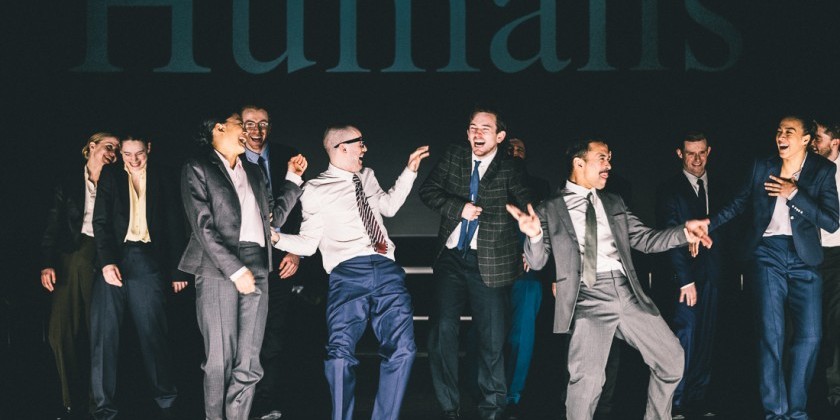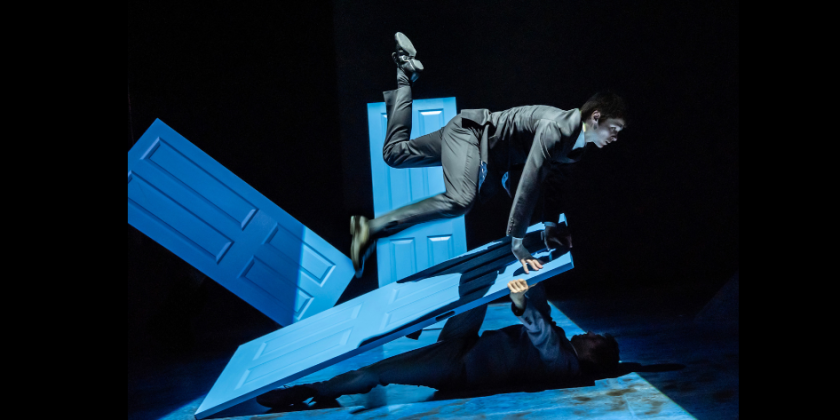IMPRESSIONS: Cara Hagan's "Mama Piranha" at JACK!

Written and Directed by Cara Hagan
Choreographed by Cara Hagan
Sound Design by Cara Hagan
Scenic Design by Rodrigo Pocidonio
Dramaturgy by Gabri Christa
Stage Management by Austen Parent
Lighting Design by Dani Draper
Voice of “The House,” by Christopher Collier
Voice of “The Magnolia Tree,” by Rebecca Larkin
Date: June 13, 2025
Mismatched area rugs decorate the small stage at JACK! Theater. On one, a table with a tea kettle atop it; on another, a shelf with a small doll house. From the ceiling hangs an assortment of random objects: a coffee mug, a lampshade, a calculator, a measuring cup, a tiny umbrella. A wicker basket and an old suitcase give the setting an inviting feel, like a cozy cabin in a remote wood frozen in time. A recorded voice begins describing an idyllic scene: a flowing river next to a house with a large magnolia tree swaying above it. However, when performer/choreographer Cara Hagan closes the stage door and enters the space, the bucolic vibe begins to change.

At first, Hagan’s careful attention to the objects within the house suggests care and pleasure in returning to its safety after a long absence. She has a cup of tea at the table and adjusts the miniatures in the dollhouse. A male voice speaks almost without interruption — at first seeming to come from a disembodied narrator — but soon reveals itself to be the voice of the house, as it repeatedly asks Hagan to dance on his floors. Although Christopher Collier’s voice barely varies in tone, his passive-aggressive insistence reveals a sinister nature: “You know how much I enjoy it.” Hagan acquiesces as a child’s voice calls, “Mama!” over and over. Her movements, as well as the child’s cries, become more frantic the longer she ignores them.

For Hagan, Mama Piranha began as a visual exploration of life and motherhood in a society increasingly devoid of human connection. The artist created a series of watercolor spills, one batch made from unfinished cups of tea to represent the demands of the outside world and the other painted in brilliant colors to represent the vividness of her inner landscape. (These and other works can be viewed in brochures available in the lobby, but are not necessary for the effectiveness of the performance piece.) On stage, Mama Piranha reveals itself as a work of physical theater where movement, spoken word, sets, and props exist symbiotically to convey feelings of turmoil, tension, and eventual release.
When a female voice enters the narrative — the voice of the magnolia tree, read by Rebecca Larkin — it sounds like a crone imparting ancient wisdom. The tree, perhaps a personification of Hagan’s inner knowing, reminds her that she once begged the river to swell, washing her and the house away. Suddenly a bucket hanging above the table tips, water pouring out like rain through holes in a roof. Sounds of surging waves and crashing objects take the place of both narrators as Hagan is drenched, her frantic movements upsetting the cabin’s contents. After the storm ends, the house is in disarray, yet Hagan is soothed.

A dynamic performer, Hagan’s movement vocabulary can be described as modern dance-weighted, articulate through the spine, a mixture of symmetrical and asymmetrical body shapes. Both her small gestures and more full-bodied expressions are concise and evocative; nothing is superfluous or simply decorative. Her profoundly expressive face shifts between fear, ecstasy, frustration, and longing to communicate turmoil within. While her embodiment of a non-linear narrative is clear and strong, it is the weaving together of her performance with theatrical elements that gives the work its power.
The magnolia tree, represented by a cloth hanging in a corner, cascades pink and white leaves to the ground when it is tilted. Like the bucket of water during the storm, any internal structures or human manipulation remain unseen. A fireplace grate glows from an unseen light source behind it. Hagan unties curtains and pulls them down from the ceiling, as she does with a dress she changes into after the storm. In a space as intimate as JACK!, this precisely-executed stage magic, as well as Hagan’s attention to detail, captivates and serves to anchor viewers in a concrete physical setting while illuminating the inner workings of her mind.

Mama Piranha is not a performance to be simply watched and enjoyed. Through a collection of archetypes, viewers are invited into a fever dream that urges engagement. While much of the imagery is concrete, the abstraction of familiar scenarios invites audiences to consider context based on their personal experiences. For instance, is the crying child Hagan herself, actual children she lost or gave up, or a metaphor for anyone abandoned and unseen in our culture? The house, with its incessant cajoling and storytelling, could be the voice in Hagan’s own mind, the memory of an abusive partner, or the incessant demands of a world that requires more and more effort just to make ends meet. Or it could be all of those things at once.

As Hagan sifts through both physical and metaphorical debris, her final image is one of rebuilding. She rights the dollhouse, setting it downstage close to the audience, and adjusts its contents. She opens the stage door to the lobby, letting light and fresh air back in.
Ultimately, Mama Piranha reminds us that each of us are builders, constructing our personal worlds, and through that, constructing the wider world we share. If what we have built isn’t serving us anymore, we can, and must, build something new.












